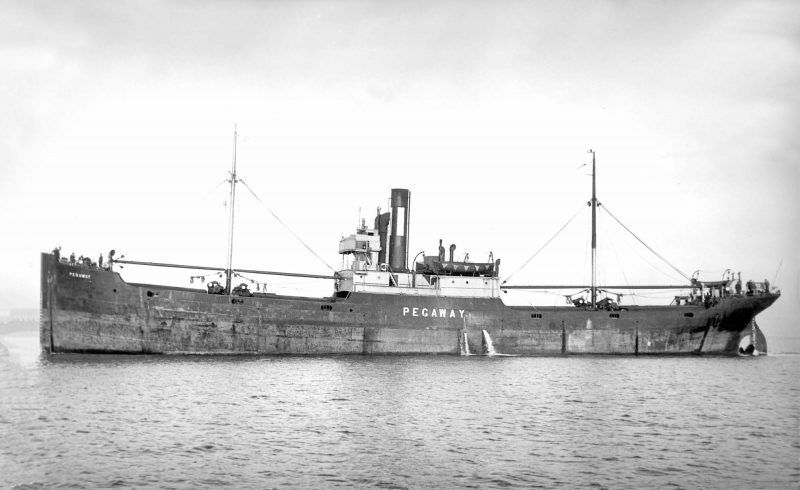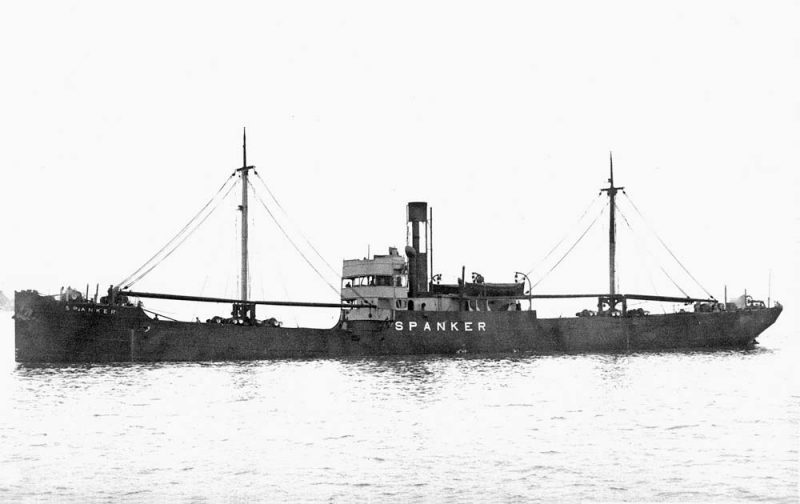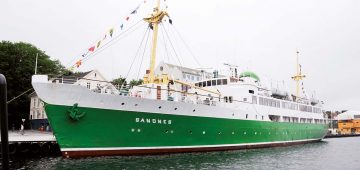A North East Collier Company


A modest-sized fleet of 42 colliers was owned and managed over an eighty year period by this Newcastle partnership. Harry Everett learned the shipping business in the offices of the Newcastle Steam Ship Co. Ltd. (J. J. & C. M. Forster), which had owned nine colliers between 1883 and 1899 including two named Newcastle, and featured three black diamonds on their funnel. He then set-up in partnership in 1899 with J. W. Witherington and purchased two old Sunderland-built colliers, Mercator and Nereus, both of which had started life in the collier fleet of James Westoll of Sunderland. Sunderland connections were strengthened in 1903 with the take-over of seven colliers of the Hill family of Sunderland, which had been in business on the coal run to London and Southampton for the previous thirty years. A new company, the John George Hill Steam Shipping Co. Ltd. was set-up to own this fleet.
Wallsend was purchased from the Burnett Steamship Co. Ltd. in 1900 and their new collier Tyne was delivered in June 1903 to give a modest-sized fleet of eleven colliers managed by the two partners. However the forty-year old Nereus was lost in November 1903 when she grounded in the Thames while on a voyage from the Tyne to London with coal. A new-building programme of thirteen new colliers entered service over the next ten years, half given the names of local rivers and half given names suggesting speed and liveliness, although they were no faster than any of their competitors at a modest loaded speed of only ten knots. The new Vectis of 1913 from the Crown yard at Sunderland continued this connection with Southampton and the Isle of Wight, the first Vectis having been wrecked at Renny Point on 5th February 1912 while on a voyage from Plymouth to Swansea in ballast. A significant proportion of company voyages were from Cardiff and South Wales ports to Le Havre and Rouen with coal.

The sisters Aln and Wear of 1911/12 were sold on immediately, Aln completing as Ford Castle for Lambton & Hetton Collieries Ltd., with Wear departing for Australian waters where she had a career lasting 33 years. Gemini had been sunk by a collision at the end of 1904, Quickstep had been wrecked at lnchkeith in 1907, Skipjack at Staithes in 1909, and Wear on the west coast of Guernsey in 1910, and other older colliers in the fleet were broken up.
The fleet was thus twelve almost new colliers on the outbreak of the Great War, the doyen of the fleet being Wallsend of 1893. However the fleet fell to ten colliers on the day of the outbreak of the Great War as both Fleetwing and Sprightly were trapped at Hamburg and interned for the rest of the war with only Fleetwing recovered when hostilities had ended. Three other colliers were lost to enemy action or marine casualty during the war:-
- 9.9.1915 Wallsend – collision/sunk near Gull Light Vessel on a voyage from the Tyne to Rouen with coal.
- 9.9.1917 Swiftsure – mined/sunk in Shapinsay Sound.
- 13.3.1918 Tweed – torpedoed/sunk 10 miles from St. Catherine’s Head, Isle of Wight.
Tees of 1907 was sold during 1916 to the Pelton Steamship Co. Ltd. and renamed Alto, and new colliers entered service as Spanker in 1917 and Lightfoot in 1916, although the latter was immediately sold on to the Wandsworth, Wimbledon & Epsom Gas Company.
Four Norwegian colliers were managed for the Shipping Controller during the war, with Saima 1,147/1914 being lost to a torpedo in 1918.
Eight colliers were left in the owned fleet at the end of the war, with Thames sold on to Swansea owners during 1919. A large replacement programme of a dozen colliers was embarked upon between 1920 and 1930 with two purchased and ten new engines-amidships vessels.
The greatest size of the fleet was thus reached in 1929 of 18 colliers. An engines-aft Norwegian collier joined the fleet in 1920 as Swiftsure, and the three-year old Chilton in 1928 from the Durham Steamship Co. Ltd. (T. Smith), Newcastle without change of name.
The ten new colliers were:-

- Lightfoot, Sprightly and Speedfast of 2,700 dwt from the Crown yard on the Wear and intended for Continental trading and for Mediterranean trading in the summer.
- Pegaway of 2,700 dwt, and Crackshot and Alacrity of 3,500 dwt from Smith’s Dock Co. Ltd. on the Tees.
- Four sisters Chevychase, Granta, Quickstep and Royston of 4,200 dwt from Smith’s Dock Co. Ltd. on the Tees.
An analysis of the two hundred voyages made by Chevychase of the Hill Steam Shipping Co. Ltd. over a seven-year period between her completion in October 1926 on the Tees and the end of 1933, showed she spent most of her time trading to Continental ports such as Hamburg, Dunkirk, Rouen, Stettin, Rotterdam, Ghent, Bordeaux, Terneuzen etc. with only 62 voyages made from the Tyne and North-East ports to Beckton and Erith on the Thames. She sailed to the Mediterranean three times with Tyne coal, two cargoes for Marseilles and one for Malta returning with phosphates from Algiers and Sfax. She also twice unloaded coal at Gibraltar for the naval base, and then returned with iron ore from Huelva and Setubal, and also supplied coal to Devonport naval base on a number of occasions from South Wales or Scottish ports. On fourteen occasions she unloaded coal at Scandinavian ports such as Aalborg and loaded pit props in Swedish ports for Hull, Hartlepool or Cardiff Remarkably, she was only laid-up once for ten days in the Tyne at the beginning of 1933 during this Depression period.

Lightfoot under Capt. Metcalf made 240 voyages from her completion at the Crown yard in 1922 until the end of 1929, mostly to Continental ports e.g. Hamburg, Stettin, Antwerp, Le Havre, Amsterdam, Hoboken, Rouen, Bremen, Ghent, Rotterdam etc. She made some voyages to the Baltic with coal, returning with pit props from Swedish ports such as Koningsberg, Kotka and Yxpila. She also supplied the naval bases of Portsmouth, Portland and Devonport from the Tyne and South Wales ports. She made a dozen voyages to the Mediterranean during this period, loading at the Tyne or Seaham for Marseilles, Cannes, Trapani in Italy or Oran, and returning with phosphates from Tunis or Casablanca or iron ore from Huelva. These round voyages usually took 35 to 40 days and were made during the summer months, with the loading of phosphates in North Africa or iron ore at Huelva taking only two to three days.
Speedfast under Capt. Cook made 160 voyages from her completion in 1924 at the Crown yard until the end of 1927. Her maiden voyage was from Sunderland to Hamburg with coal, and she was mostly engaged in Continental trading to Ghent, Amsterdam, Hamburg Rotterdam, Bremerhaven, Rouen, Aalborg, Le Havre, Zandevoort, Vlaardingen, Bordeaux Boulogne, Dunkirk, Stettin, Danzig and Santander, returning with iron ore from Bilbao. She made six voyages to the Mediterranean with coal loaded in the Tyne or Seaham for Marseilles, Cannes, Algiers or Bona returning with bauxite from Toulon, zinc ore from Carloforte or phosphates from Sfax or Casablanca. She made some voyages from the Tyne to Erith on the Thames as well as several to the naval bases of Portsmouth, Portland and Devonport. After unloading at Hamburg the Kiel Canal was sometimes entered at Brunsbuttel to load timber at Baltic ports for the U.K.

Sprightly under Capt. Wood made three hundred voyages from her completion in 1923 at the Crown yard until the end of 1930. She traded to the same Continental ports as her two sisters, and was also used on the Tyne coal run to Erith, Barking or Bevan’s Wharf during the whole of 1930 on charter to Stephenson Clarke. She many voyages from South Wales ports with coal for the naval bases of Devonport, Portland and Portsmouth, and also to Sheerness and the Thames. She made six Mediterranean voyages, loading at Seaham each time for Marseilles, Cannes or Bona returning with phosphates from Tunis, Oran or Casablanca and usually calling at Gibraltar for bunkers. She was also often seen in the Baltic, loading timber at Fredrikshavn, Jacobstad, Koningsberg, Kotka and Yxpila.
Spanker of 1917 had many Masters during her 26 year career with the company, and her longest voyage took her as far as Aden during a six-month charter to the Admiralty in 1935. She sailed from Devonport on 29th August with coal and was at Malta from 16th September to 6th October, and at Alexandria from 10th October to 11th December. She then sailed down the Red Sea to Aden and spent a few days there at anchor over Christmas and the New Year. She was back in Alexandria during January 1936 and at Malta for three days from 16th February, arriving back at Devonport on 7th March. She had previously taken coal to the naval bases of Rosyth, Portland, Portsmouth and Devonport from North-East or South Wales ports on many occasions. She traded mostly to Continental ports e.g. Antwerp, Amsterdam, Aalborg, Bremen, Boulogne, Danzig, Dieppe, Dunkirk, Ghent, Hamburg, Hoboken, Le Havre, Oslo, Santander, Stettin, Temeuzen, Vlaardingen, Zandevoorte and Zeebrugge. She was also a regular vistor to the Irish ports of Cork and Dublin. She made several voyages with Tyne coal to the Mediterranean ports of Marseilles, Cannes, Salemo or Bona, returning from Toulon with bauxite or from North African ports with phosphates. She often loaded timber in the Baltic at Carlskrona, Kasko, Yxpila or Mollersvik for Hull, Hartlepool or Bo’ness. She was laid-up at Blyth for a few days in July 1933 and then made two voyages to Bergen and Sauda in Norway with coal for power station use. She had made 550 voyages by the end of August 1936 and had just returned from Port Brule in the Belgian canal system, having entered via Flushing and Antwerp, and was a regual vistor to Sluiskil near Zeebrugge.
Pegaway foundered on 4th April 1938 some 30 miles from Terschelling while on a voyage from the Tyne to Hamburg with coal. The fleet on the outbreak of war in December 1939 was nine colliers, five under the Hill Steam Shipping Co. Ltd., two under the Granta Steamship Co. Ltd. and founded when delivery was taken in 1927 of a ship of the same name, and two under Witherington & Everett.
The directors of the companies were Arthur S. Witherington of Sunderland, Arthur G. Everett of Gosforth and H.P. Everett of Sunderland. Four company colliers became war casualties:-
- 12.1.1940 Granta – mined/sunk 11 miles from Cromer Knoll L.V. on a voyage from London to Blyth in ballast, 12 lost.
- 9.3.1940 Chevychase – mined/sunk in North Sea to N of Cromer on a voyage from Blyth to London.
- 4.5.1941 Royston – damaged by bombing off Humber and sank in tow the next day. She had been on a voyage from Hartlepool to London with coal.
- 12.1.1942 Quickstep – mined/sunk off Thames Estuary on a voyage from London to The Tyne in ballast, 13 lost.
The managed Edvard Nissen was sunk at Dunkirk as a blockship in June 1940, and the managed Knut was mined and sunk in December 1942. Spanker was sold in 1943 to fellow Newcastle owners Furst & Browne and renamed Hillsider in 1947. Two standard war-built colliers and two American-built ships and the Canadian laker Lachinedoc as well as two captured German prizes were managed by the company during the war. There were four owned survivors from the large pre-war fleet at the end of the war, Skipjack of 1910 which had survived two World Wars intact, Lightfoot of 1922, Speedfast of 1924 and Crackshot of 1924. Skipjack was sold during 1946 to London owners but was unfortunately mined and sunk off Ravenna during August of the same year. She was replaced by the purchase of the managed Empire Strait of 4,200 dwt and renamed Granta. She was registered under the Granta Steam Shipping Co. Ltd. as were the remaining vessels of the Hill Steam Shipping Co. Ltd., which was wound up that year. However the fleet of four steam colliers was reduced in 1947 to three with the sale of Speedfast.
The pre-war directors of the companies had been joined in post-war years by H. G. Witherington of Whitburn. However they presided over a fleet of only one collier, Granta, by September 1954 due to the fall off in coal shipments to the Continent. Lightfoot was sold to the old-established Monroe Brothers Ltd. of Liverpool in 1953 and renamed Kyle Queen, with Crackshot sold in early 1954 to Italian owners who renamed her Maria Pompei. A brief entry in the company fleet list in 1954 was Spanker (2) purchased as Highwood from the High Hook Shipping Co. Ltd., managed by E. R. Newbigin, but she was lost a few weeks later on 8th August when she was wrecked on the North pier at the Hook of Holland while on a voyage from Rotterdam to London in ballast.
A new type of motor coaster was required to modernise the fleet, and three such ships were built at the yard of Jos. L. Meyer at Papenburg, with Fleetwing of 2,180 dwt in April 1956, Chevychase of 1,370 dwt in September 1956, and Sprightly of 2,244 dwt in June 1959. Granta was sold for scrap after the complete collapse of the Continental coal trade and arrived at Hemixem in Holland on 26th June 1959, and the new Fleetwing was sold later that year to Finnish owners. The Continental coal trade was replaced by a joint liner service by the two remaining motor coasters from London to North African ports in partnership with Harris & Dixon Ltd. of London. This was to last only ten years until both ships were sold in 1969/70 to the Eskgarth and Eskglen Shipping Cos. Ltd. with Comben, Longstaff as managers.

So ended another of the many Newcastle shipping partnerships founded on coal.




Comments
Sorry, comments are closed for this item